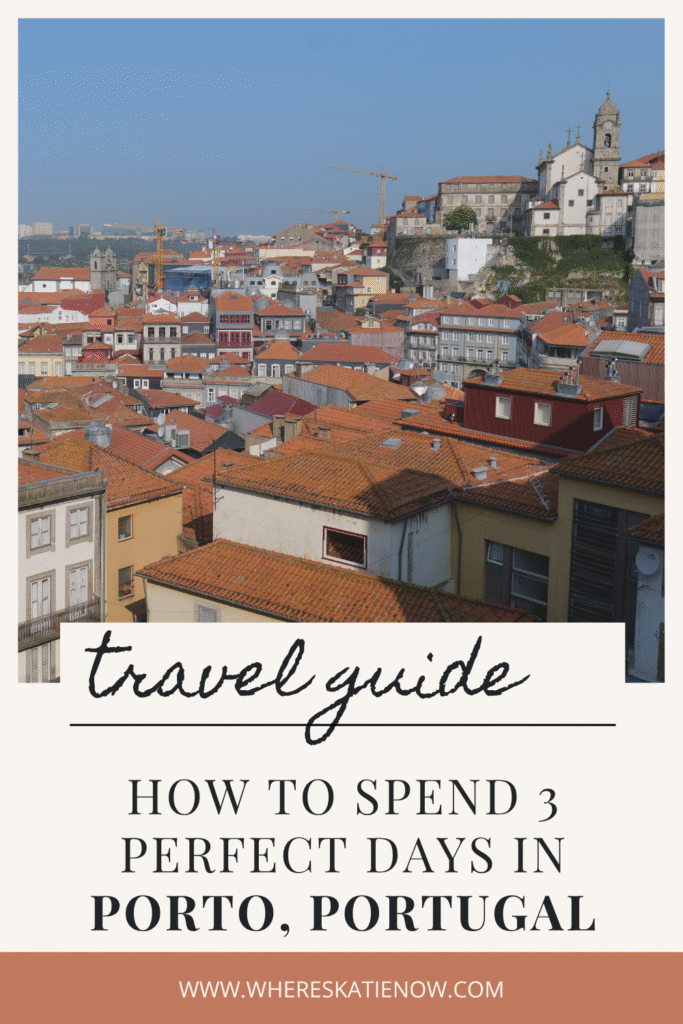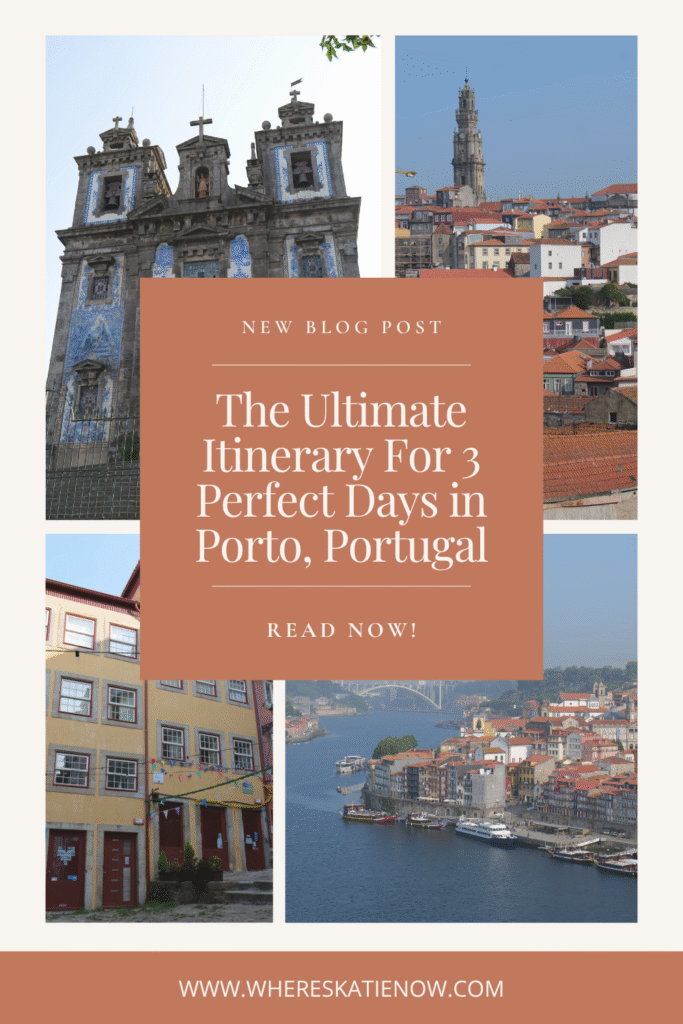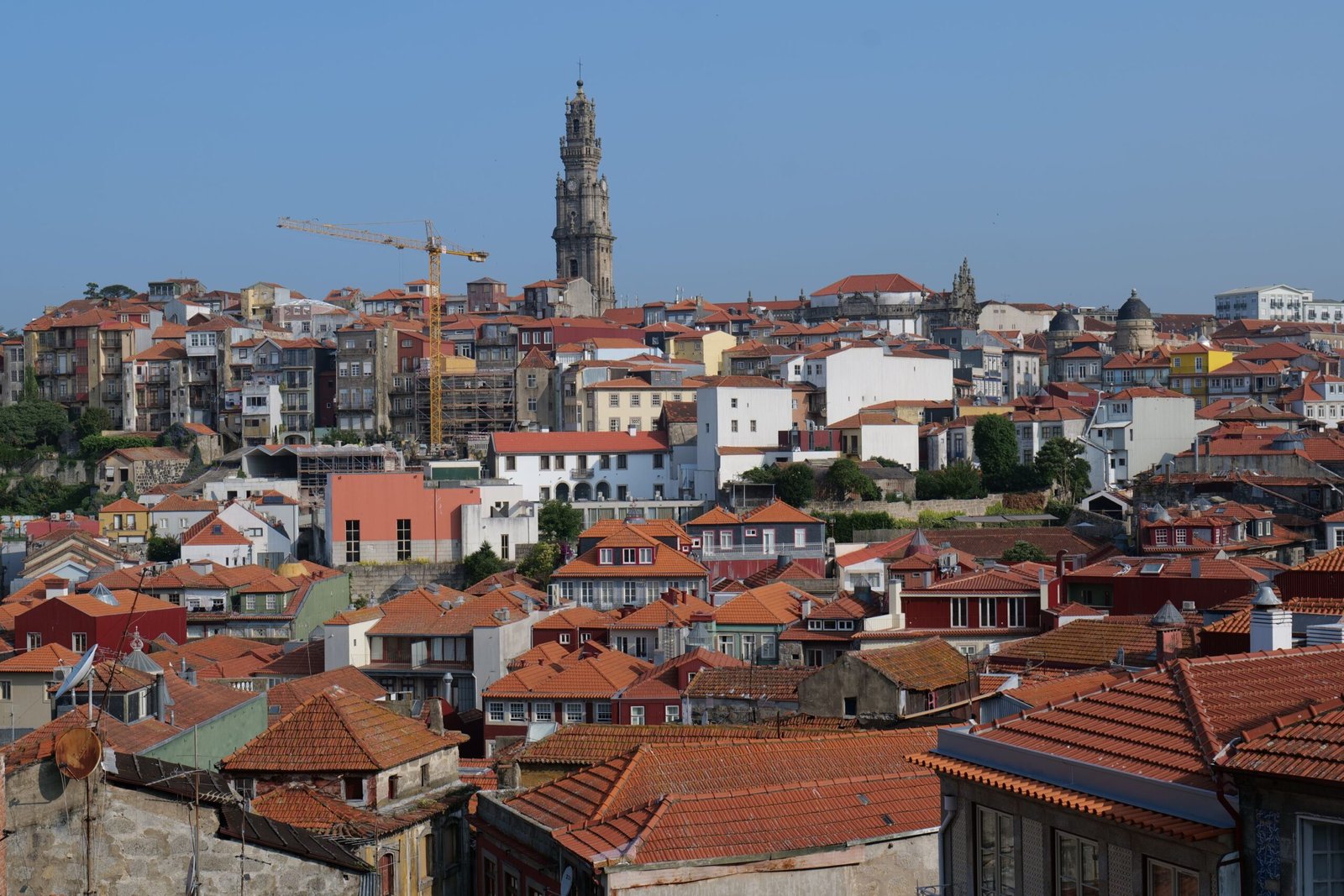How to Spend 3 Days in Porto: Your Perfect Porto Itinerary
Planning how to spend 3 days in Porto can feel weirdly overwhelming for such a laid-back city.
There’s just so many iconic landmarks and hidden gems packed into its steep, cobbled streets and charming riverside – tiled churches, sunset viewpoints, port wine cellars, hidden miradouros…
And I get it, the last thing you want is to leave feeling like you missed out on the good stuff.
Well, I’ve visited Porto as a solo female traveller, figured out what’s worth your time (and what’s okay to skip!), and built this itinerary to hit all of the key sights and hidden gems – without feeling overwhelmed or rushed.
So whether you’re dreaming of golden hour over the Douro River, standing inside the jaw-dropping São Bento station, or sipping port in Gaia, this one’s for you!
Ready? Let’s map out your dream 3 days in Porto!
Disclaimer: Some of the links on this blog are affiliate links. That means if you click on one and make a purchase, I may earn a small commission – at no extra cost to you. I only recommend products, places and services I genuinely love and use on my own solo travels. Thank you for supporting my adventures so I can continue to provide free content on this blog! 💛
Where is Porto?
Porto is a vibrant, hilly city in the northwest of Portugal, right where the Douro River meets the Atlantic Ocean. It’s the country’s second-largest city after Lisbon, but it feels so much more compact, laid-back and personal, especially as a solo female traveller!
The historic centre of Porto, Ribeira, is a UNESCO World Heritage site, and Porto is also the birthplace of Port wine!
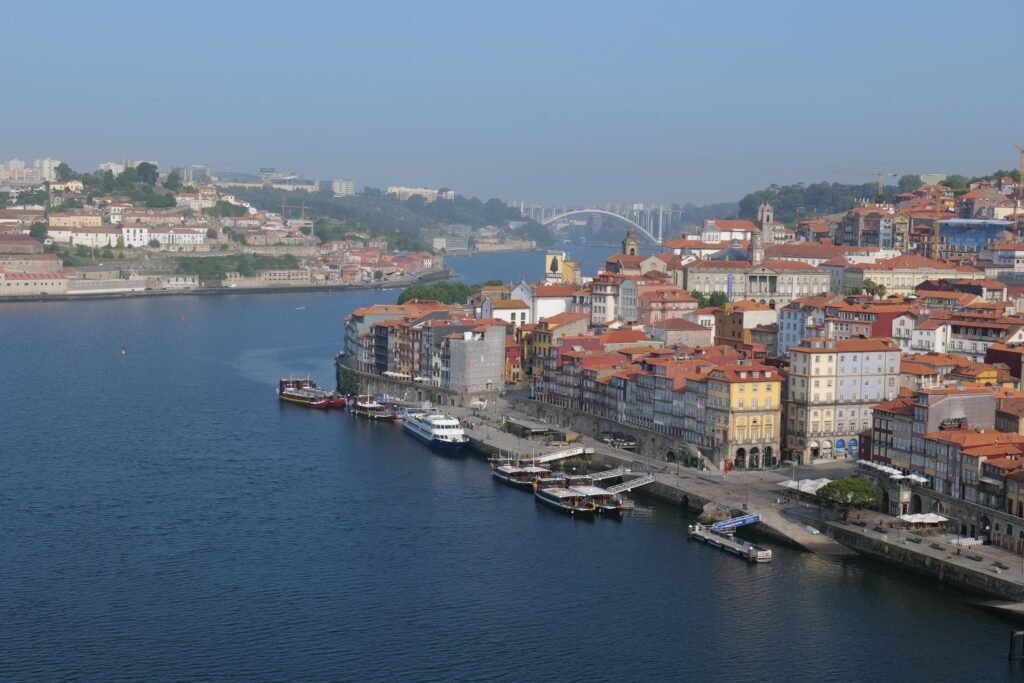
Is Porto Worth Visiting as a Solo Traveller?
Absolutely! Porto is one of those rare cities that manages to feel both exciting and totally manageable as a solo female traveller.
It’s walkable, has a friendly atmosphere, and has enough going on to keep you busy without feeling overwhelmed during your 3 days in Porto.
And safety-wise, Porto (and Portugal in general), has a low crime rate compared to other European cities, especially when it comes to violent crime.
You’ll want to stay alert for pickpocketing in busy tourist spots like São Bento Station, the Dom Luís I Bridge, etc, but overall it’s a calm and very friendly city for tourists!
Plus, there are so many amazing things to do in Porto as a solo traveller, that it is well worth visiting for the views alone! (More on this in the itinerary!)
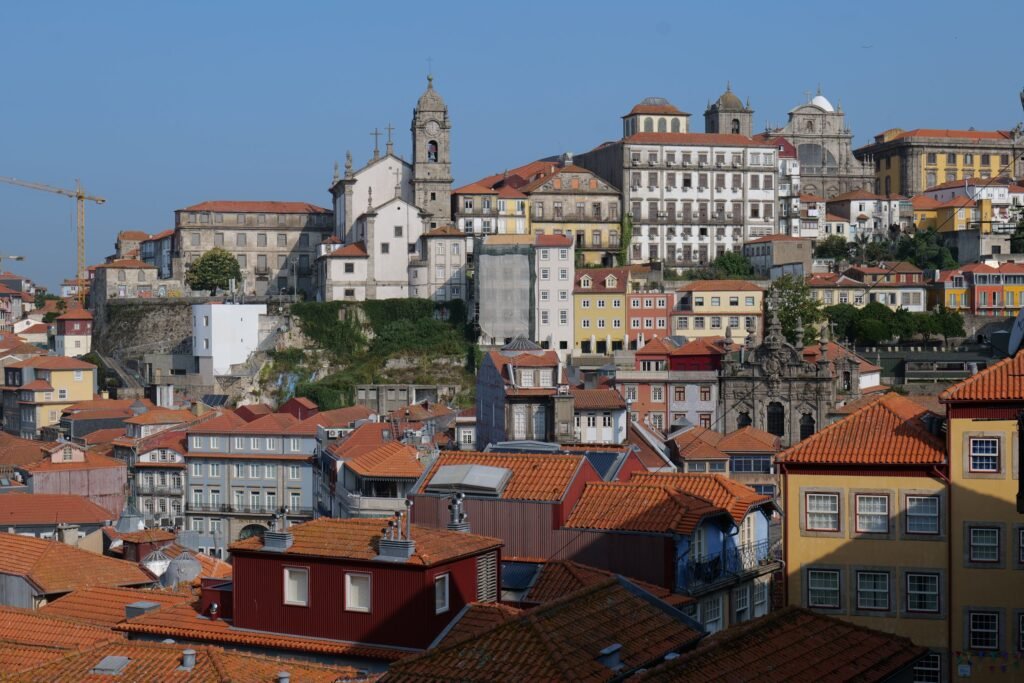
Is 3 Days in Porto Enough?
Yes! 3 days in Porto is the perfect amount of time to enjoy the city without rushing.
It gives you enough time to explore the Ribeira district, taste your way through the Port wine cellars in Gaia, and even fit in a day trip to the Douro Valley or nearby Braga and Guimaraes, if you’re feeling adventurous.
Bottom line: if you’re planning a 3 day itinerary for Porto, you can absolutely hit the highlights (and a few hidden gems along the way!), in a way that is not overwhelming or rushed.
And this 3 days in Porto itinerary will show you exactly how – so let’s get to it!
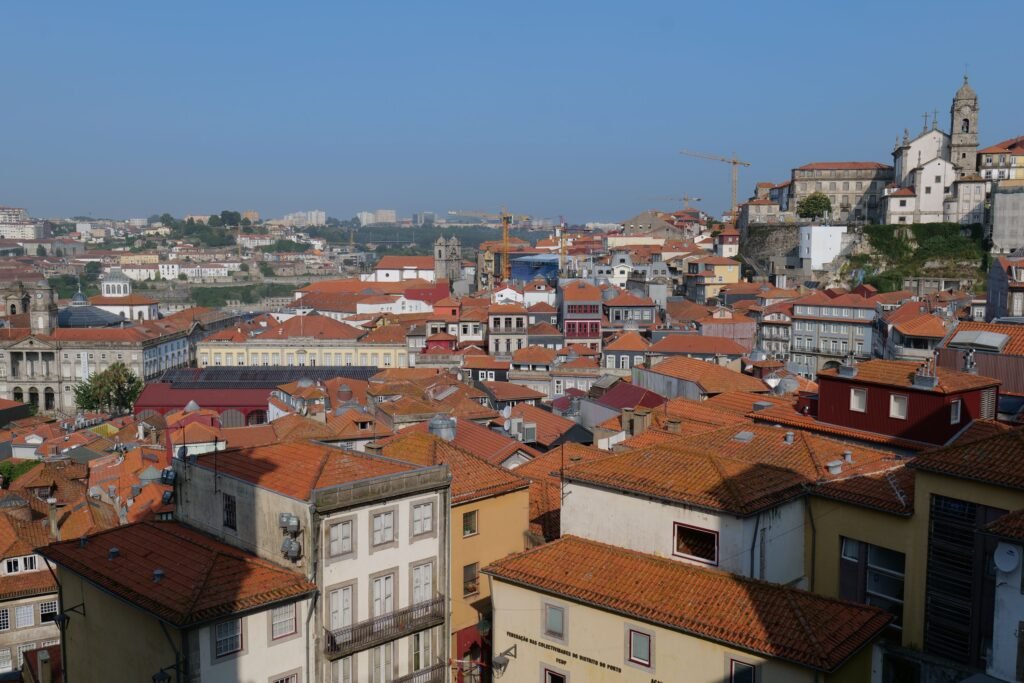
Porto Day 1: Self-Guided Walk Through Ribeira + Boat Trip
Start your first morning in Porto gently, with a walk through the colourful, cobbled, UNESCO-listed Ribeira district – arguably the most iconic and beautiful part of the city!
This walk is the perfect way to ease into your 3 days in Porto. It takes around 1 hour without stops – but you’ll absolutely want to take your time!
This area of Porto is packed full of cobbled side streets, dramatic viewpoints, centuries-old buildings, and stunning riverside views. And this walk captures it all.
You’ll start from the top in Porto city centre, walk downhill through the oldest parts of the city, cross the iconic Luís I Bridge, and end up at the lively riverside in Ribeira.
This area is best explored slowly (which is why I’ve dedicated your first full morning to doing just that), and you’ve got two great options:
- Explore at your own pace (I’ve laid out a step-by-step route below!)
- Or join a guided walking tour for more context and some company along the way. (If it’s your first solo trip or you’re a history lover, the guided option is a great way to ease into the city with a bit more structure and the knowledge of a local guide!)
If you’re taking the self-guided option and want a map to follow, you can find my exact Google Maps here.
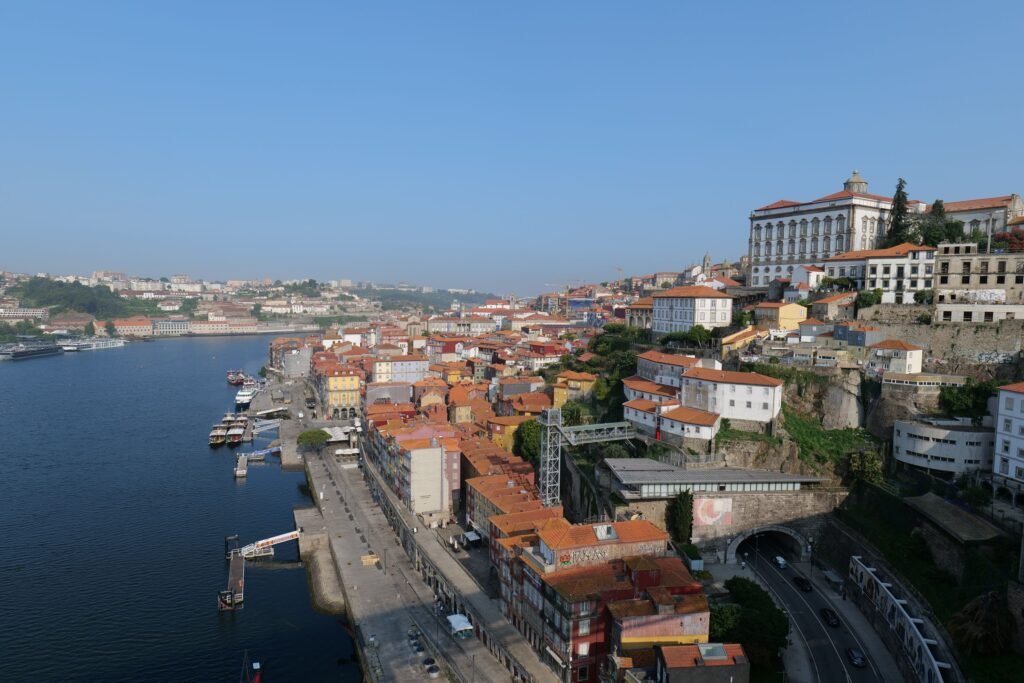
Morning: Ribeira Self-Guided Walking Tour
Stop 1: Miradouro da Vitória
Tucked down an unassuming side street, this first stop feels almost secret, but it’s one of my favourite viewpoints in the whole city of Porto!
Miradouro da Vitória overlooks the iconic Ribeira rooftops, the Luís I Bridge and the Douro River.
There are no signs for this one (at least there weren’t when I visited). So just head to the end of Rua de São Bento da Vitória, and you’ll find a stone platform with a low wall and that view.
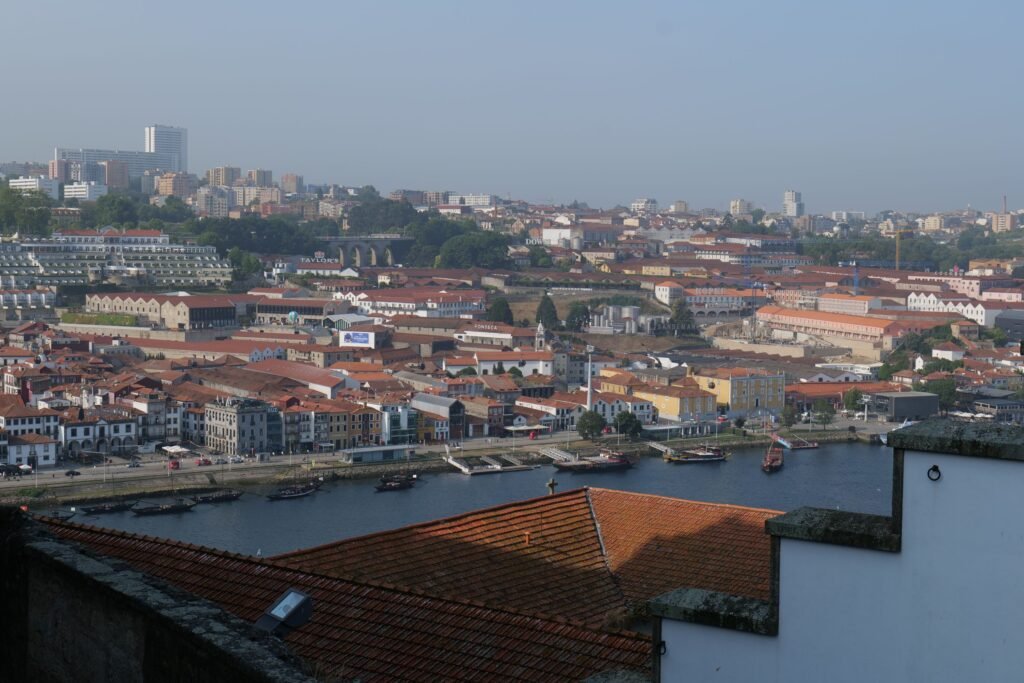
Stop 2: Miradouro da Rua das Aldas
As you walk downhill from Vitória, your next stop is another beautiful viewpoint: Miradouro da Rua das Aldas.
What I love here is how the street opens up unexpectedly into a small terrace with stunning views of the river and the terracotta rooftops below!
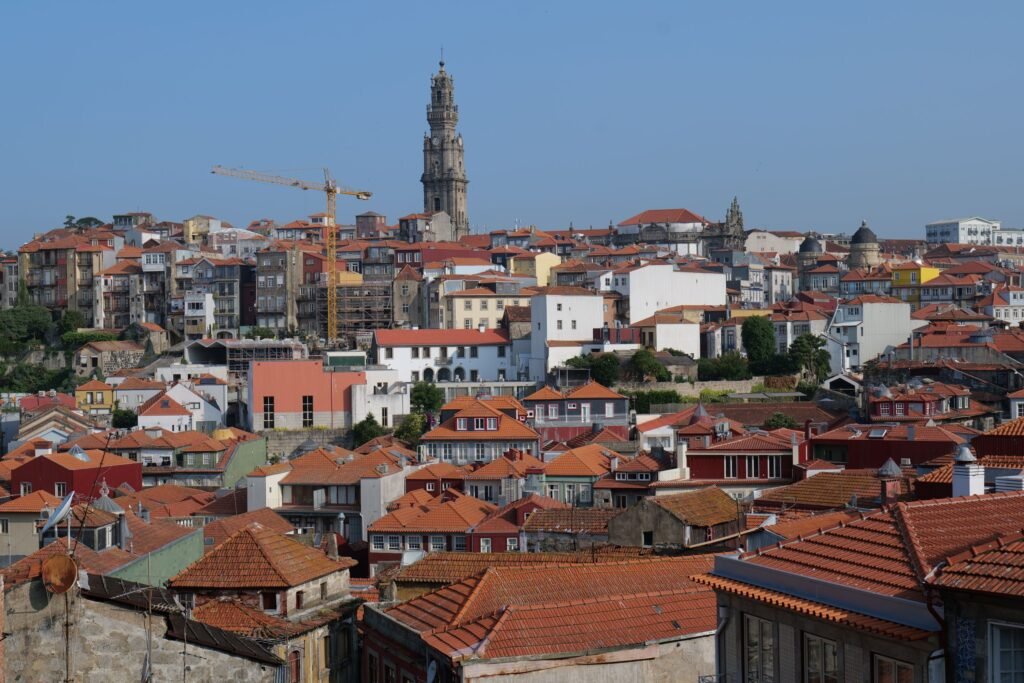
Stop 3: Porto Cathedral (Sé do Porto)
This 12th-century Romanesque cathedral is one of the most important buildings in the city’s history, and it offers so much more than just grand architecture!
Be sure to visit inside if you have time (there is a small charge for the cloisters), and marvel at the Romanesque rose window, the Gothic cloisters and the magnificent silver altarpiece.
From the outside of the cathedral, the terrace gives you one of the best views back over the city, with the terracotta rooftops stretching below your feet to meet the sparkling Douro river.
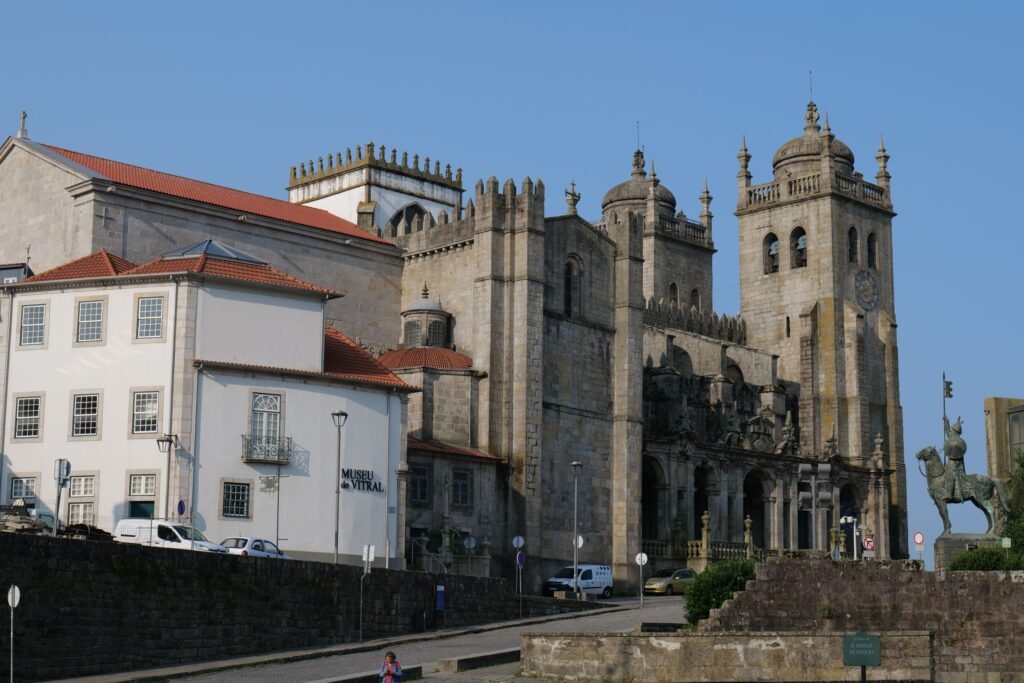
Stop 4: Muralha Fernandina
Just a few steps from the Cathedral, you’ll come across the remains of the medieval Muralha Fernandina (aka the Fernandine Wall).
These defensive stone walls once encircled the entirety of Porto city, and standing here, you get a real sense of the city’s layered, defensive past.
It’s easy to miss if you don’t know to look for it, but it’s a powerful piece of Porto’s history and a great photo stop!
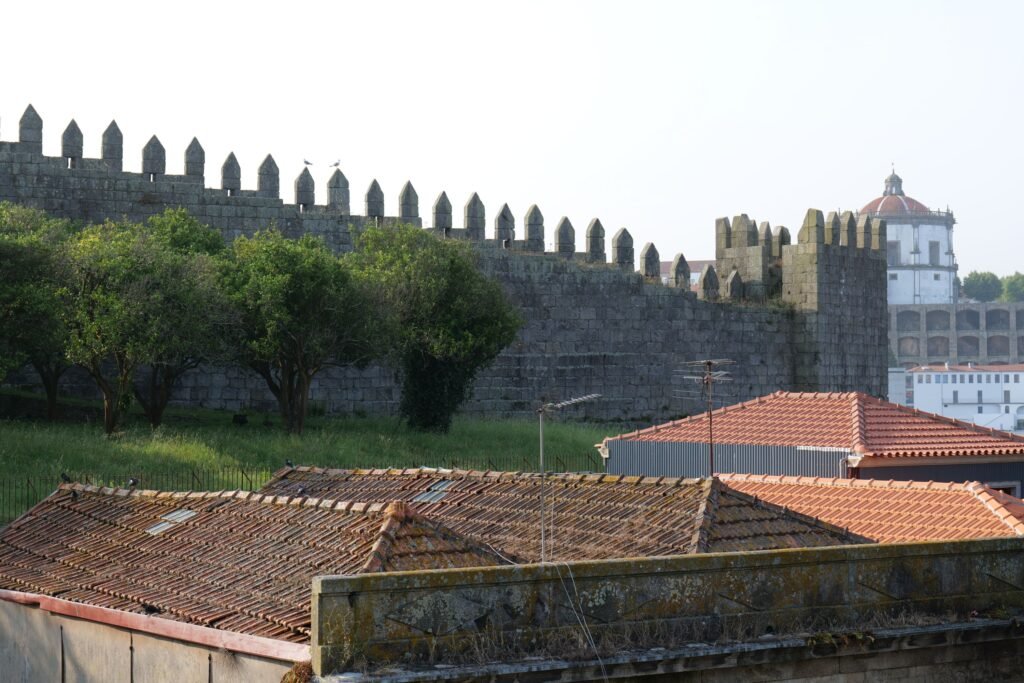
Stop 5: Cross the Luís I Bridge
It’s now time to cross one of Porto’s most iconic landmarks: the double-decked Dom Luís I Bridge!
It was designed by a student of Gustave Eiffel, and once you see the ironwork you’ll see the familiarity with the famous Eiffel Tower in Paris!
You’ll be crossing the bridge on the upper level, which is for pedestrians and the “D” metro line running to and from Gaia.
Both sides of the bridge give you stunning views along the Douro river, so I would recommend you choose one side to walk on the way out and then pick the other side on the way back.
The best photo spot is halfway across, looking back toward Porto (the right-hand side of the bridge). Plus, if you go early in the day, you’ll have soft light and fewer people around too!
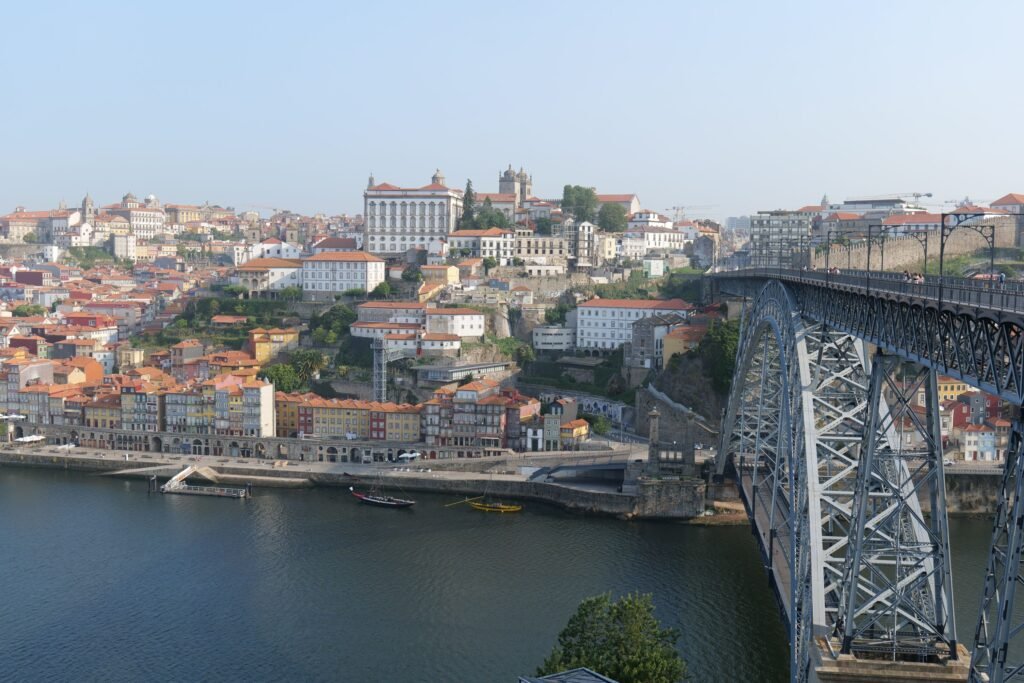
Stop 6: Miradouro da Ribeira (Gaia Side)
Once you’re across the bridge, turn right and head towards the Miradouro da Ribeira on the Gaia side.
From here, you get that postcard-perfect shot of the Ribeira waterfront, with the colourful houses sitting along the river, with the bridge off to the side. You’ll also see the traditional Rabelo boats (once used for transporting port wine) bobbing below you!
This is a great place to sit for a few minutes, grab a drink or snack, and just admire the view.
You could also choose to explore Gaia from here, if you wish. You’ll see that even though they’re separated only by the river, they have very different vibes!

Stop 7: Monastery of Serra do Pilar
Just a short walk from the miradouro is one of Gaia’s most dramatic viewpoints.
The Mosteiro da Serra do Pilar isn’t just a historic monastery, it’s also a UNESCO World Heritage Site with arguably the best panoramic views in Porto!
Built in the 1500s, this former monastery is known for its round church and beautiful cloister – as well as those views, of course!
You can admire the monastery from the outside and then walk the perimeter, known as Miradouro da Serra do Pilar, for the full sweep of the Douro river, the Ribeira district, the bridge, and the riverbanks curving and stretching off into the hills.
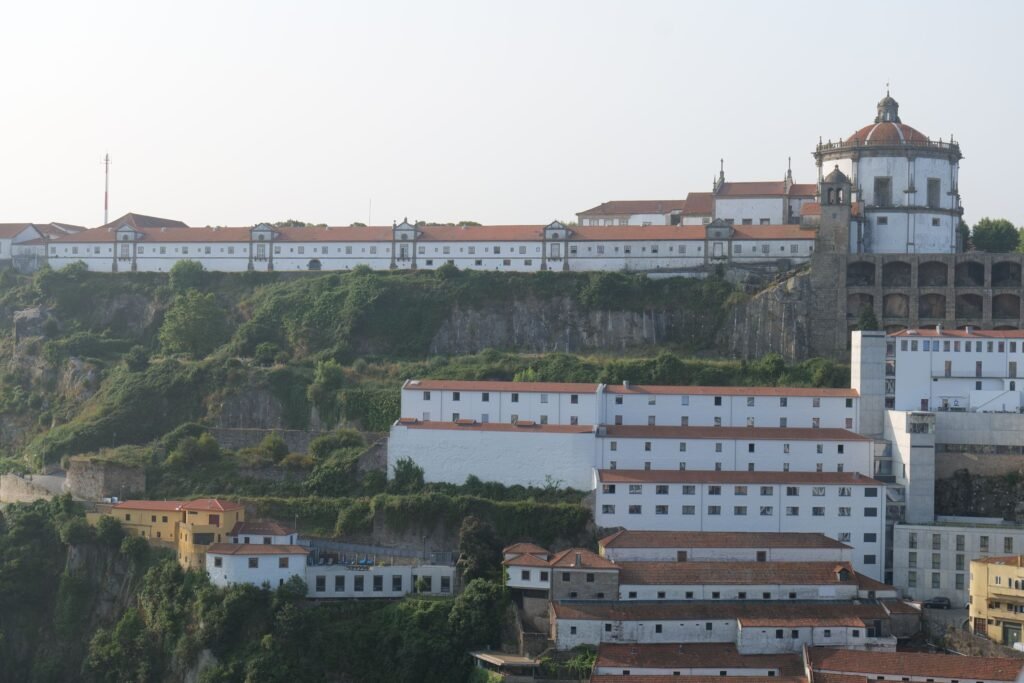
Stop 8: Cais da Ribeira and Ribeira Square
After exploring Gaia, head back across the bridge and down to the heart of Ribeira, via cobbled streets and into the buzzing Praça da Ribeira (Ribeira Square).
This riverside square is full of restaurants, bars, music and life, but it’s still got a laid-back feel in the earlier part of the day!
This is the perfect place to pause for a snack and rest your feet after a full morning of walking!
Katie’s Top Tip: If you don’t fancy walking back across the Luís I Bridge, there’s also the option to take the cable car from the Gaia riverside back to Porto. It’s a short but scenic ride with gorgeous views over the Douro River. Just bear in mind it’s a one-way trip, so only take it if you’ve finished exploring Gaia and taking photos from the bridge!
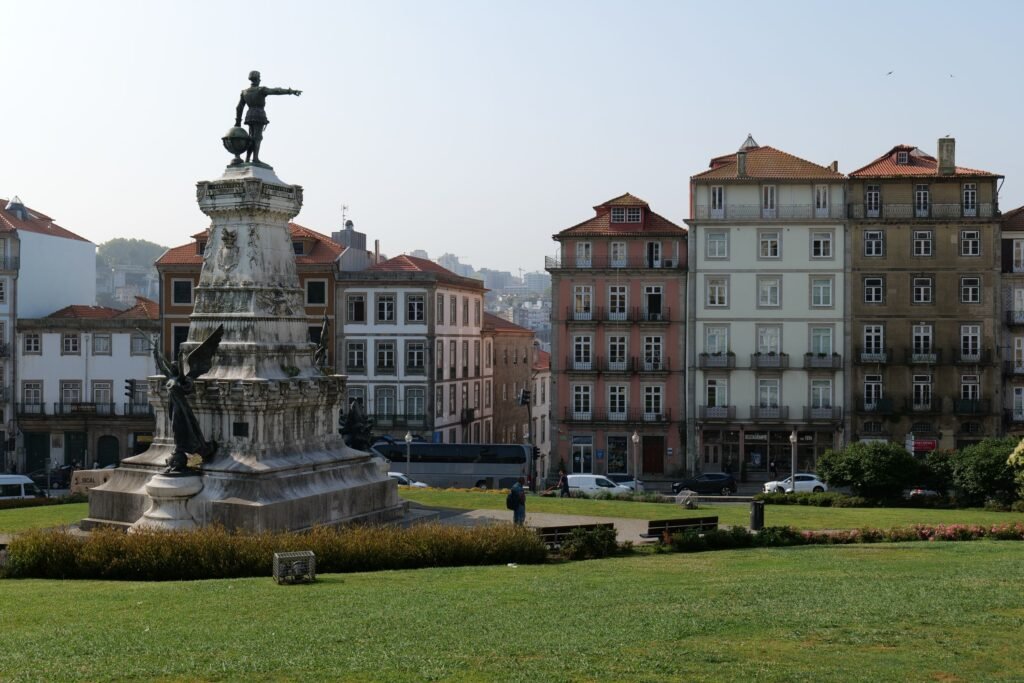
Stop 9: Church of Saint Francis
Just a couple of minutes’ walk from Ribeira Square, via the beautiful waterfront promenade of Ribeira, is the Church of Saint Francis.
The 14th-century exterior might look muted (at least compared to earlier Porto Cathedral), but the interior is incredibly ornate, with carved wood and gilded accents.
Inside, you’ll get to admire the ornate interior of the church itself, the atmospheric catacombs and a small museum. It’s well worth a visit!
Stop 10: Palácio da Bolsa
Your final stop of the morning is just next door: the grand Palácio da Bolsa, just off the Praça do Infante D. Henrique square.
This 19th-century neoclassical building was once the city’s stock exchange, and it’s such a grand building to admire, both outside and inside.
You can only visit inside on a guided tour (takes 30 minutes), which runs in several languages (English, Spanish, Portuguese and French) and costs €14.
The highlights of the interior tour are visits to the ornate library, Noble Staircase, Hall of Nations, Court Room and Jury Room.

Optional: Guided Walking Tour
If you’d prefer to explore this route with a local guide, this 3 hour morning walking tour follows a similar route to my self-guided one, but dives much deeper into Porto’s fascinating layered history, from Roman times to the modern-day wine industry.
Early Afternoon: Lunch in Ribeira
Here are a few great options for lunch in Porto’s Ribeira neighbourhood:
- Taberna dos Mercadores (Portuguese food)
- The Wine Box (tapas and wine)
- Ribeira Square Restaurant (local dishes)
- daTerra (vegan)
Late Afternoon: Douro River Cruise
After your walk, it’s time to take the pressure off your feet and let a boat tour continue your sightseeing through Porto!
One of the most relaxing and scenic things to do during your 3 days in Porto is take a Douro River cruise. This Porto boat tour, on a traditional Rabelo boat, takes 50 minutes.
Along the way, it gives you a front-row seat to the city’s six iconic bridges, the colourful riverbanks of Ribeira and Gaia, and some pretty stunning photo ops along the way!
This boat trip departs from the Ribeira quay (Cais da Ribeira) and operates frequently throughout the day (approx. every 30 minutes), so unless you’re travelling in peak summer, you can be spontaneous about when you sail!
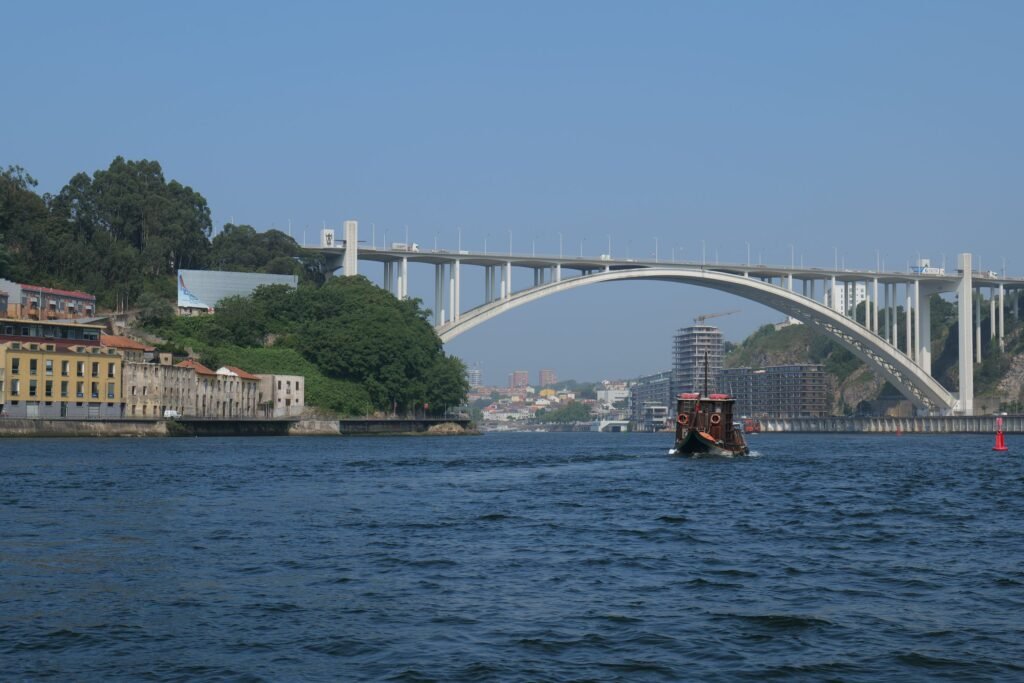
Evening: Port Wine Tasting in Gaia
No 3 days in Porto itinerary would be complete without sipping port wine straight from the source!
Gaia (where you visited this morning, as part of our self-guided walk), is home to dozens of traditional wine cellars where you can tour the facilities, learn about the port-making process, and enjoy a guided tasting.
I would highly recommend this tour of Cockburn Lodge (the largest Port cellar in Gaia!)
The 1.5 hour guided tour gives you a proper behind-the-scenes look at how Port is made, aged, and blended.
You’ll start in the on-site museum where you’ll learn about Cockburn’s 200-year history, then walk through working cellars lined with thousands of oak barrels, where you might even spot the coopers (the people who build and repair barrels) in action!
The tour ends with a tasting, and you can choose what you wish to taste: classic Ports, vintage and aged Tawnies, chocolate pairings, or even cheese pairings if you’re feeling extra indulgent!
It’s a great mix of learning the fascinating history, admiring the craftsmanship, and drinking very good Port!
Katie’s Top Tip: Book in advance, especially if you want one of the premium tastings with chocolate or cheese pairings. They’re popular but totally worth it!
Sunset: Mosteiro da Serra do Pilar
To end your first day in Porto, return to the Mosteiro da Serra do Pilar.
This former monastery sits just above the Luís I Bridge on the Gaia side and offers the most iconic sunset view over the city!
You’ll see Porto’s terracotta rooftops glowing orange, the river winding beneath your feet, and Ribeira slowly lighting up for the night as Porto starts to get dark.
There’s a peaceful public terrace here where you can sit with a snack or drink after your tasting, and just soak in the view!
To get back to Porto city centre after sunset, take the metro line D from Jardim do Morro back across the bridge into Porto. As an example, the metro ride from Gaia to Sao Bento Station takes just 3 minutes.
Day 2: Self-Guided Walk Through Porto City Centre
Morning: Porto City Centre Self-Guided Walking Tour
The best way to get a feel for a city is by walking through it!
Porto is wonderfully compact, and day two of your 3 days in Porto itinerary is all about enjoying the atmosphere of the historic city centre.
This self-guided walking route includes some of the most beautiful buildings in the city, a few quiet hidden corners and plenty of opportunities to stop for photos!
The full walk takes around 50 minutes.
Or, like with yesterday morning’s walk through Ribeira, if you’d prefer something a bit more structured (especially if you’re nervous about navigating on your own or want to learn more of the history), there are also some great local-guided walking tours too!
This top-rated, small group option includes many of the same stops below, plus insights from your local guide that you wouldn’t get alone!
If you’re taking the self-guided option and want a map to follow, you can find my exact Google Maps here.
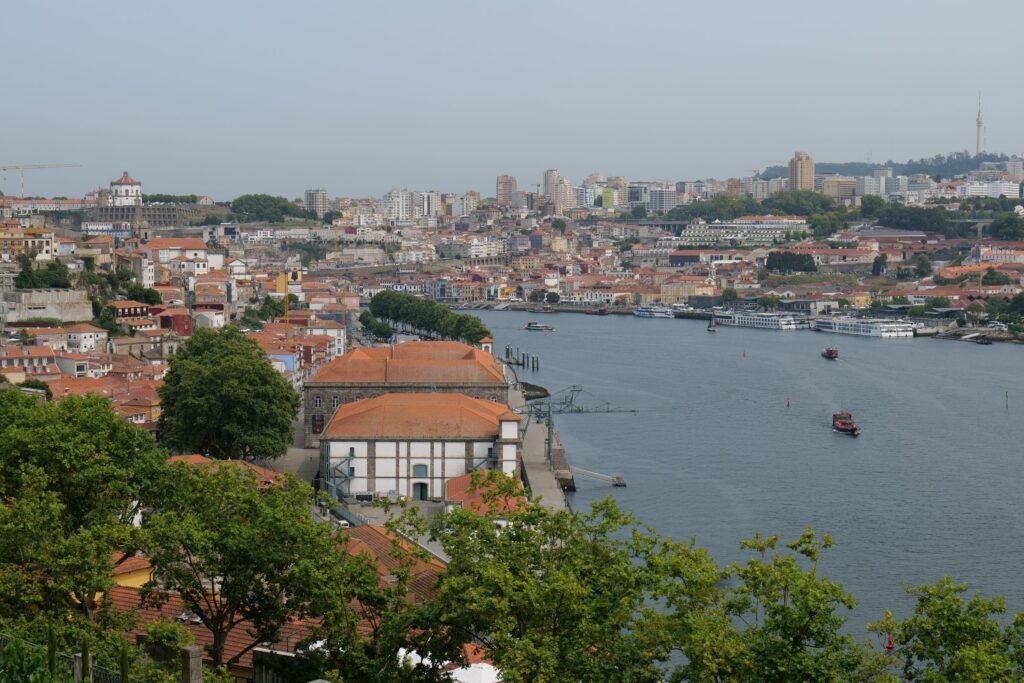
Stop 1: Capela das Almas (Chapel of Souls)
Covered in over 15,000 hand-painted blue and white azulejos (tiles), Capela das Almas is one of Porto’s most photographed buildings – and for good reason!
The scenes depict the lives of Saint Francis of Assisi and Saint Catherine, and the contrast between the bright blue tiles and the otherwise ordinary shopping street of Rua de Santa Catarina makes it all the more special and photogenic.
It’s totally free to admire from the outside, and it is best visited early in the morning before the tour groups and day trippers arrive. Plus, the early morning light is lovely too!
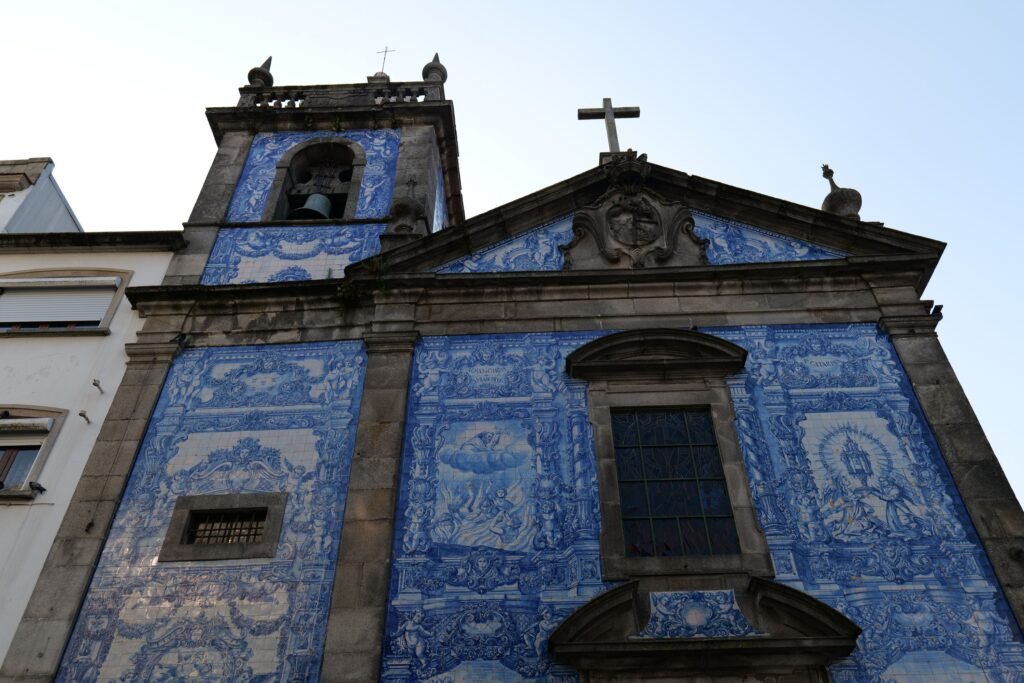
Stop 2: Praça General Humberto Delgado (City Hall Square)
Just a few steps from the Capela das Almas and right at the top of Avenida dos Aliados, this grand square is home to Porto’s City Hall.
If you visit early in the morning, you’ll find a very local vibe here, with locals passing through on their way to work or grabbing a coffee from one of the nearby cafés.
And in December, it’s the heart of the city’s Christmas lights and market.
It’s not a place you’ll spend ages, but it’s absolutely worth a photo stop of the grand City Hall and fountain!
Katie’s Top Tip: Walk up to the City Hall steps for one of the best views looking back down the Avenida dos Aliados. It’s especially pretty in the morning, before the square gets too busy!
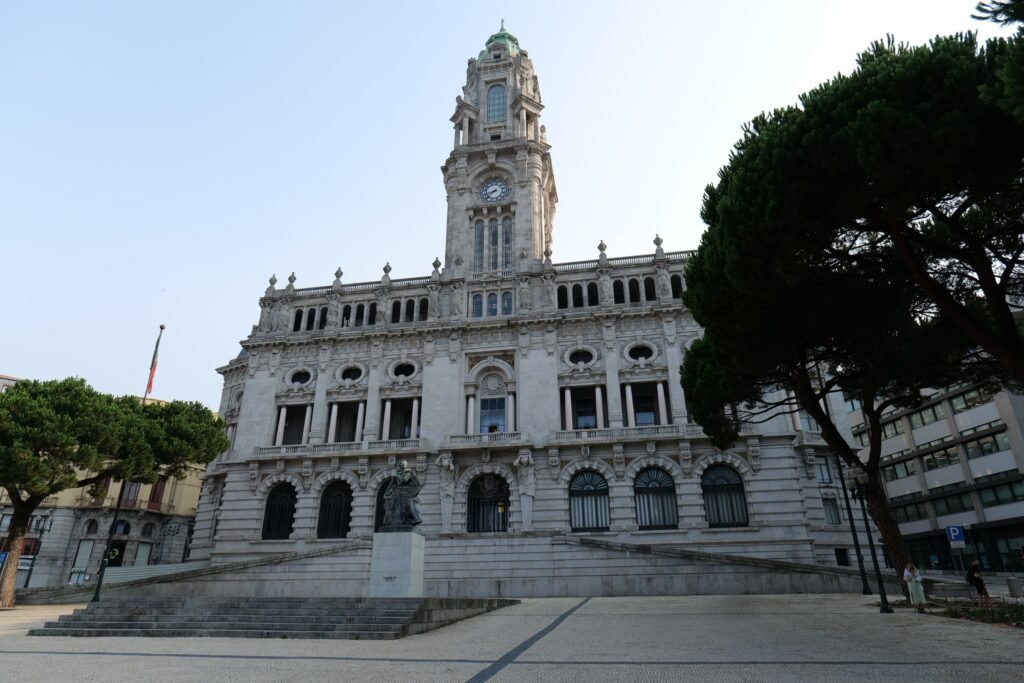
Stop 3: Igreja de Santo Ildefonso
Just a 5-minute walk from the square is the 18th-century baroque church, Igreja de Santo Ildefonso, also covered in those beautiful blue and white azulejo tiles.
Its azulejo-covered façade is a lot less famous than Capela das Almas, but just as stunning in my opinion! (And it’s usually way less crowded, especially in the morning!)
It’s again a lovely photo stop from the outside, or you could choose to visit inside, with its colourful stained glass, gilded woodwork and high, intricate ceilings. At time of writing there is a 1 euro entrance fee.
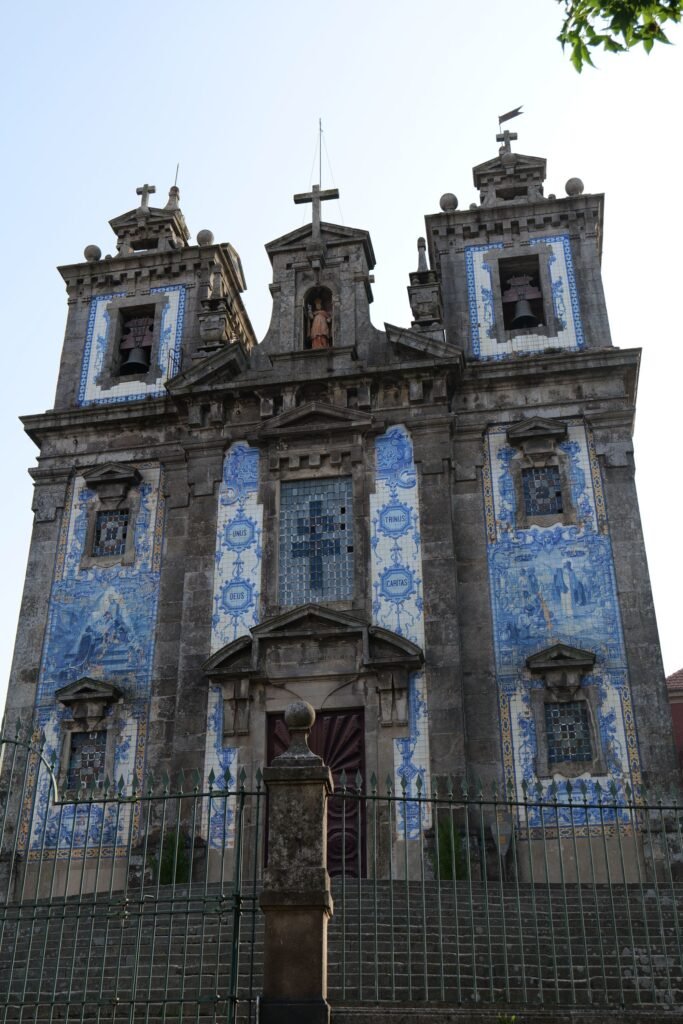
Stop 4: São Bento Railway Station
So you might be thinking: wait, Katie, why have you included a train station on a walking tour of Porto?!
Well, this is definitely not your average train station.
In fact, it is even a UNESCO world heritage site and a National Monument of Portugal!
The interior of the 20th century São Bento Station is a true artistic masterpiece, with over 20,000 azulejos (551 square metres) wrapped around the walls.
The famous blue and white tiles are truly iconic and you can’t leave Porto without seeing them. They depict key moments in Portuguese history, from battles to traditional rural life throughout the regions.
And no, you don’t need to be catching a train to explore here! Just walk into the main hall and take it all in. (In fact, I would say the majority of people who enter the terminal aren’t actually getting a train either – it’s that popular!)
Katie’s Top Tip: If you’re into photography, bring a wide-angle lens or use your phone’s wide mode. The station is gorgeous but tricky to capture without it.
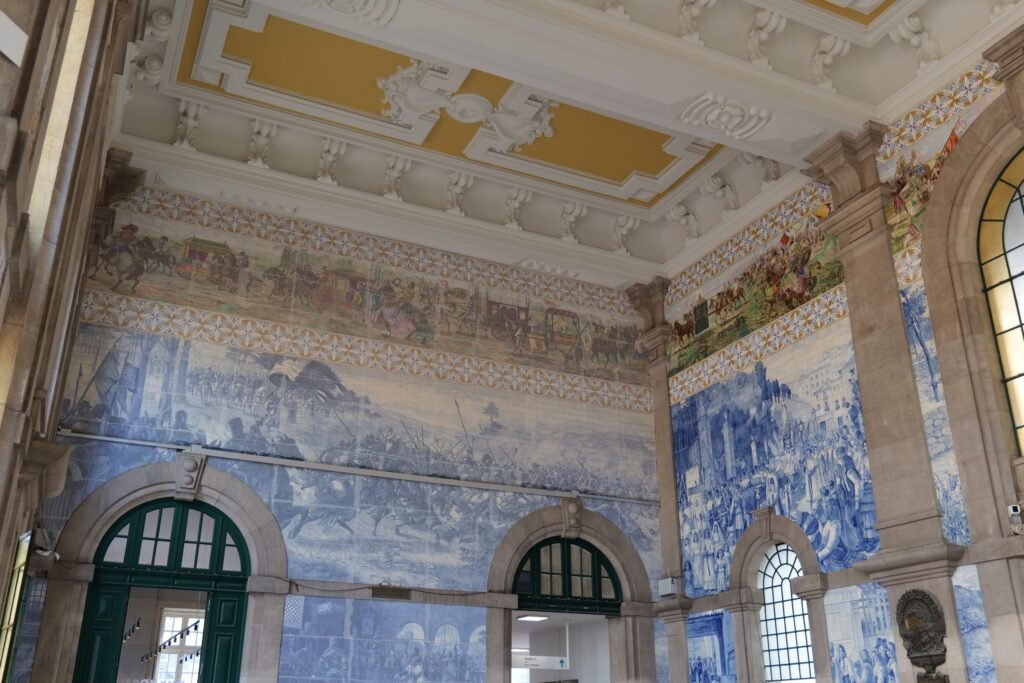
Stop 5: Praça da Liberdade + Rua da Fábrica
Praça da Liberdade is a large, open square that acts as a natural centre point for the city of Porto. It’s a great spot to get your bearings!
Today, the buildings surrounding the square are hotels, banks, offices and restaurants. In particular, you’ll find Banco de Portugal, the Palace of Cardosas and the Monument to Pedro IV.
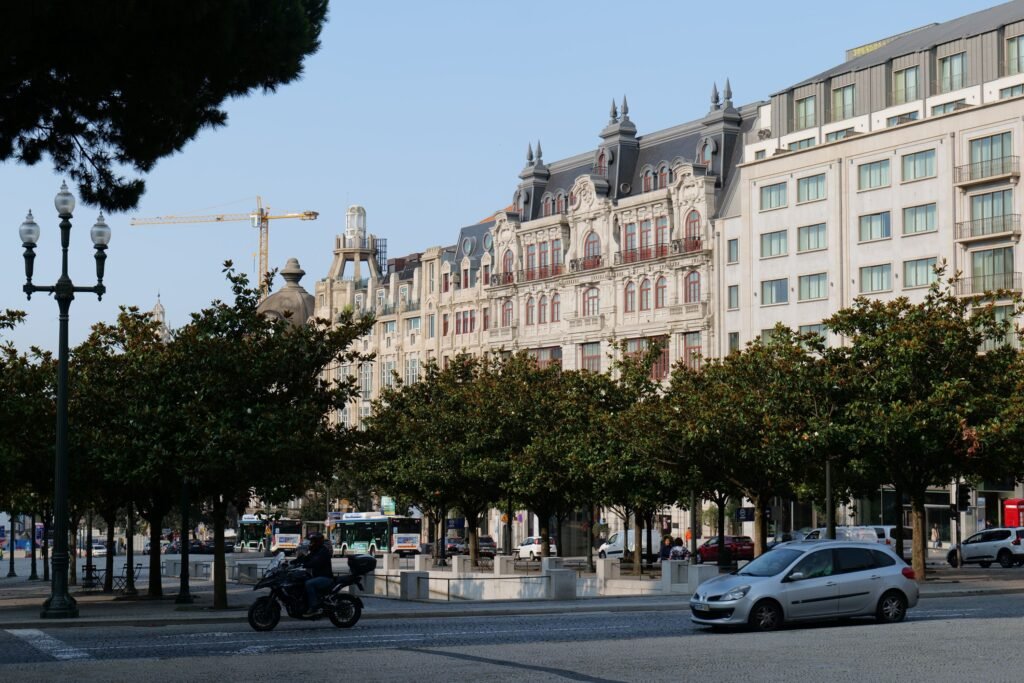
Stop 6: Igreja dos Clérigos + Clérigos Tower
You’ll spot this one before you reach it, as the Clérigos Bell Tower (a well-known symbol of Porto), rises 75m high, above the city skyline.
The 18th century, Baroque Clérigos church itself is relatively simple in terms of its exterior, but the real draw is the 200 step climb to the top of the tower.
If you’re up for it, the panoramic views are well worth the climb.
From the top, you’ll see the 49 bells of the tower as well as incredible views stretching all the way out to the Douro River and over the rooftops of Porto!
It currently costs 10 euros to climb the bell tower and enter the small museum.
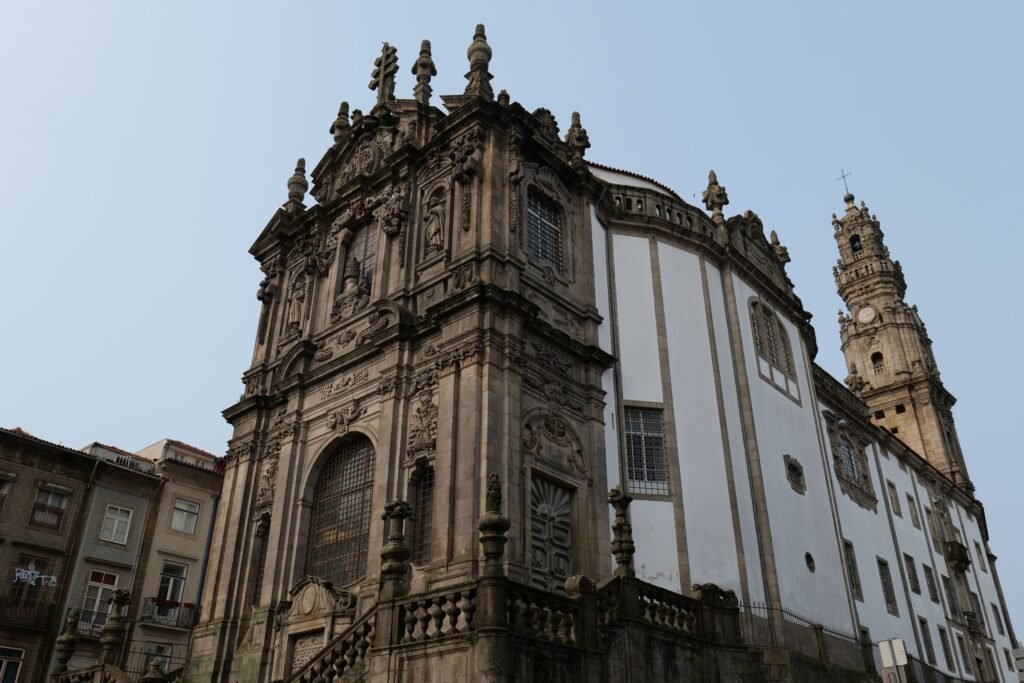
Stop 7: Igreja do Carmo and Igreja dos Carmelitas
Just around the corner you’ll also find Igreja do Carmo, yet another stunning blue-tiled church to admire – but this one has a twist!
Between Carmo Church and the adjacent Carmelitas Church is a very narrow, 3 storey house (barely 1 metre wide!) that was inhabited until the 1980s (yes, really!)
According to local legend, the “Hidden House” was built to separate the monks in Igreja do Carmo and the nuns in Igreja dos Carmelitas.
And it is now a quirky (and, in my opinion, underrated!) photo spot.
You can also visit inside the hidden house, included in the entrance ticket to the museum of Igreja do Carmo. You’ll get to see the bedrooms, living room and kitchen. It’s well worth a visit, if only for the novelty factor!
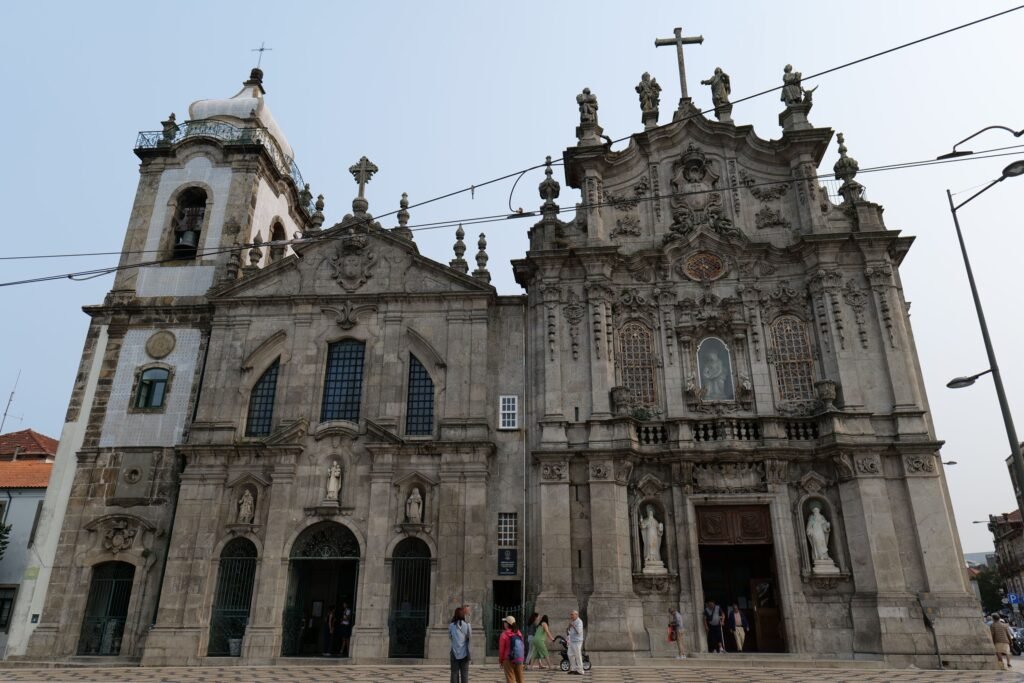
Early Afternoon: Lunch in Porto City Centre
Here are a few good options for lunch in Porto City Centre:
- Café Progresso (good brunch and coffee)
- Brasão Coliseu (Portuguese food)
- Árvore do Mundo (vegetarian/vegan)
- Pick up a picnic from a local supermarket and head to Crystal Palace Gardens to eat it (this is what I did!)
Afternoon: Crystal Palace Gardens or a Half-Day Trip to Amarante
Depending on your mood and energy levels, you’ve got two great options for the afternoon.
Crystal Palace Gardens
If you’re craving nature and want to stay in Porto city centre, head to the 19th-century Crystal Palace Gardens (Jardins do Palácio de Cristal).
These beautifully landscaped gardens are sprawling, quiet and full of peacocks, fountains, and dramatic viewpoints over the Douro River.
I actually spent a whole afternoon here during my last trip to Porto!
I sat under the trees, with a truly stunning view overlooking the Douro, in the shade, with a good book. It was so relaxing after a morning of walking and was also the perfect escape from the intense afternoon sun!
It’s completely free (so perfect for 3 days in Porto on a budget), and there is loads to do if you want to explore as well as sit and relax:
- Jardim de Buxo
- Spot the resident peacocks
- Torreão do Jardim do Palácio (this is where I sat!)
- Visit Porto’s Romantic Museum
- Miradouro da Ponte da Arrábida
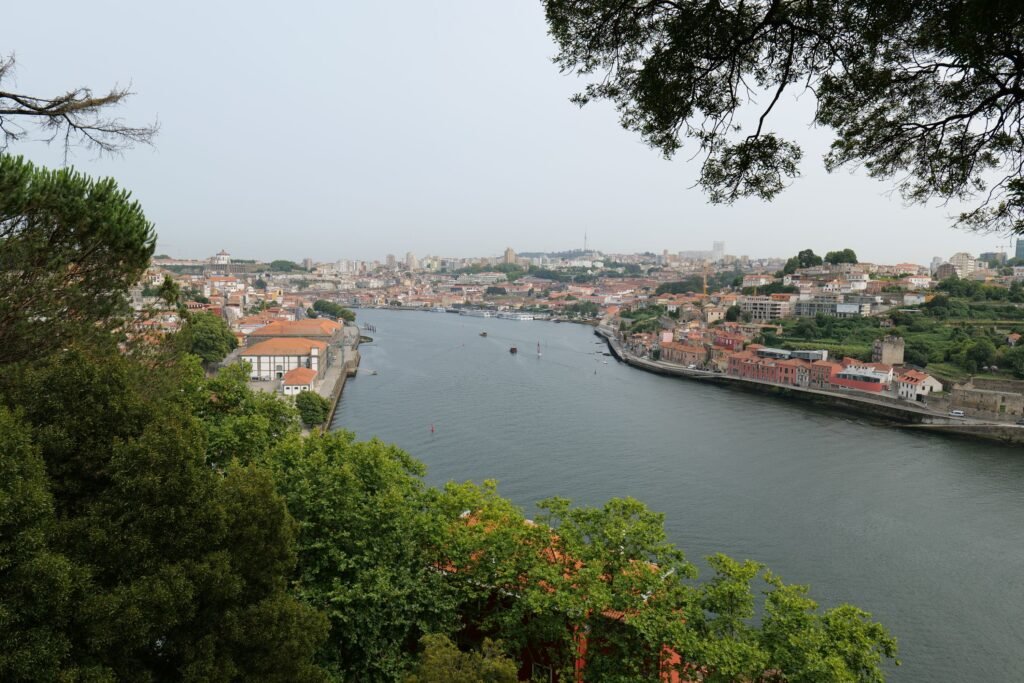
Katie’s Top Tip: Even if you decide to go to Amarante for the afternoon rather than stay in Porto, I would highly recommend you at least visit the Crystal Palace Gardens for a photo stop. It’s not far from Igreja do Carmo, so you can easily add it to your morning of sightseeing through Porto city centre!
Half-Day Trip to Amarante
If you’re feeling more adventurous, you could also choose to take a half-day trip to Amarante!
Just over an hour from Porto, Amarante is a ridiculously charming riverside town, with medieval architecture, cobbled streets, and a much more peaceful vibe than the hustle and bustle of the city centre you’ll be leaving behind!
In my opinion, it feels like the entirety of this tiny town was lifted straight from the pages of a fairytale!
I first visited tiny Amarante on a half-day trip from Porto, just like in this itinerary, and fell completely in love! (Seriously, I recommend this place to everyone!)
It’s small enough to explore on foot, but with enough to do that you won’t get bored.

Things to do in Amarante
- Admire the São Gonçalo Bridge – The town’s picture-postcard view (both from the bridge and of it!) and main crossing point over the Tamega River.
- Visit Igreja de São Gonçalo – A beautiful 16th-century church with beautiful interiors and a cloister.
- Walk (or sit!) along the riverside promenade – This quiet riverside stretch runs right along the Tamega and is especially peaceful in the afternoon.
- Try the local pastry: “Doces de São Gonçalo” – It’s cheeky in shape (you’ll see what I mean!) but absolutely delicious!
- Browse artisan shops – The town is known for its crafts and independent shops.
How to Get to Amarante from Porto
By Bus: Bus is your best option if you’re travelling without a car. Rede Expressos and Flixbus run daily buses from Porto Campanha to Amarante Central Bus Station, taking around 50 minutes. The bus station is about 10 minutes’ walk from the river.
By Car: If you’re renting a car or on a road trip, Amarante is about a 45 minute drive from Porto. It’s a really easy and direct drive, and parking is generally available near the centre. This option gives you the most flexibility to explore at your own pace, plus you can make detours along the way if you wish!
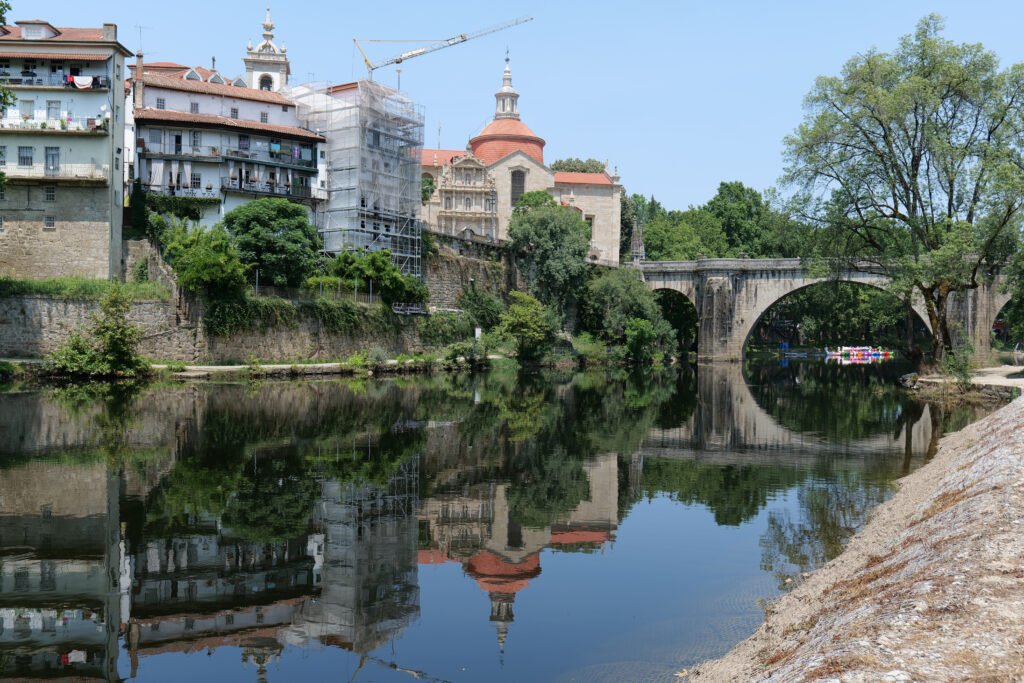
Evening: Dinner in Porto City Centre
Back in Porto for the evening, you’ll be spoiled for choice for where to eat dinner:
- If you’re in the mood for traditional, Portuguese food in a cosy setting, Taberna Santo António near Clérigos Church is a great option.
- For a more modern dining experience with vegetarian options, try Cantina 32 on Rua das Flores.
- And if you just want something casual and comforting, the sandwiches at Casa Guedes are delicious!
Day 3: A Day Trip From Porto
On your final day in Porto, it’s time to travel further afield and see a bit more of northern Portugal!
And the good news is that Porto is surrounded by some of the most beautiful, fascinating and historically rich spots in the country – and most of them are super accessible, even as a solo traveller or if you don’t drive.
I’m going to set out five of the most popular Porto day trips, each offering something different depending on your interests.
So whether you’re into historic cities, pastel-coloured canals, or sipping wine overlooking the Douro Valley, there’s a perfect fit for the third and final day of your 3 days in Porto!
Porto Day Trip Option 1: Braga
Braga is one of Portugal’s oldest cities, with impressive churches and spectacular architecture.
But don’t get me wrong, this isn’t just a city for history lovers!
Instead, Braga is compact, walkable, has a great atmosphere, and feels much less touristy than other day trip spots in Northern Portugal.
As a solo traveller, you’ll love the peaceful atmosphere and safe, welcoming vibe!
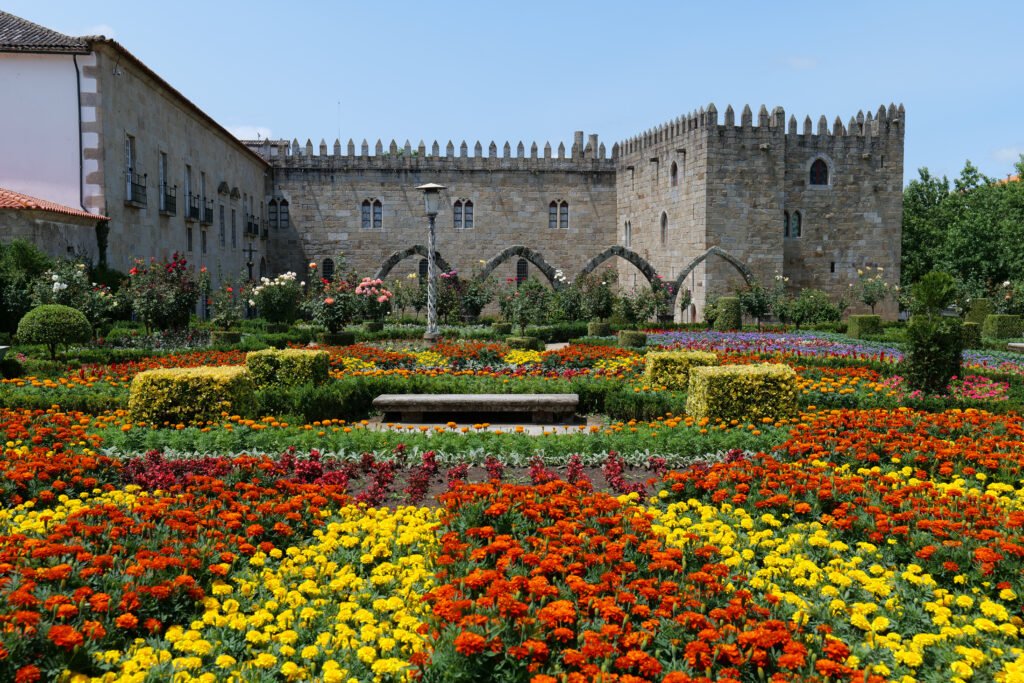
Things to Do in Braga
- Sanctuary of Bom Jesus do Monte – This dramatic hilltop pilgrimage site is Braga’s most iconic view. You can climb the zigzagging steps or take the easy option with the funicular, the oldest water-powered lift in the world.
- Braga Cathedral (Sé de Braga) – One of Portugal’s oldest cathedrals, a peaceful and beautiful stop right in the heart of the city centre.
- Jardim de Santa Bárbara – A small but pretty garden that’s particularly lovely when it’s in full bloom in the summer. It’s perfect for a peaceful walk!
- Arco da Porta Nova – The city’s famous archway makes for a great photo stop and leads straight into the charming old city.
- Praca da Republica – The perfect spot to grab a coffee or lunch!
How to Get to Braga
By Train – Direct trains to Braga from Porto Sao Bento Station take about 1 hour 10 minutes. The station is just a short 10 minute walk from Braga city centre.
By Bus – Rede Expressos, ALSA and Flixbus run regular bus routes from Porto Campanha Bus Station to Braga Bus Station, taking around 45 minutes. The bus station is an 8 minute walk from the city centre.
By Car – The drive to Braga takes around 45 minutes from Porto.
By Guided Tour – This full day Braga and Guimarães tour from Porto is a great option if you want to visit both cities in one day, with a local guide to help bring the history to life! It includes the option to book a small group tour, transport in an air-conditioned minibus, entry to both Braga Cathedral and Guimaraes Castle, a guided explanation at each stop, and plenty of free time to explore each place on your own!
By Private Tour – A private tour to Braga is perfect if you want a more personal experience! Your driver-guide will tailor the experience to your pace and unique interests, and you’ll also get hotel pickup and door-to-door service to make the logistics even smoother!
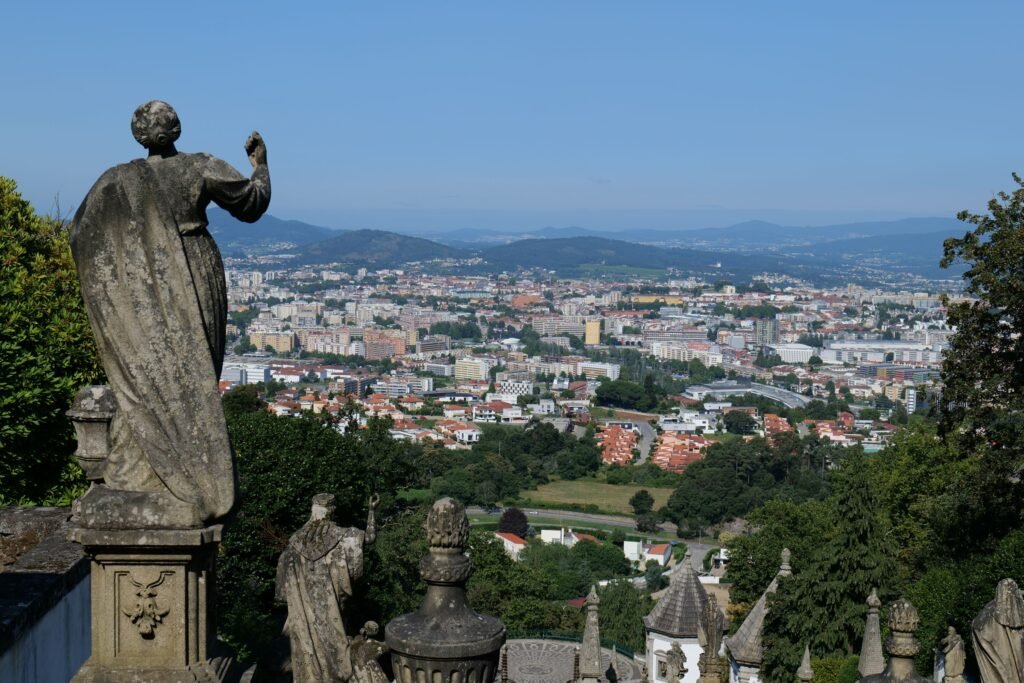
Porto Day Trip Option 2: Guimaraes
If you’re into medieval charm and cobbled streets, Guimaraes is your fairytale day trip from Porto.
Known as the birthplace of Portugal, this UNESCO-listed city is small enough to explore solo without feeling overwhelmed, but also packed with heritage and pretty little corners – so you could never be bored!
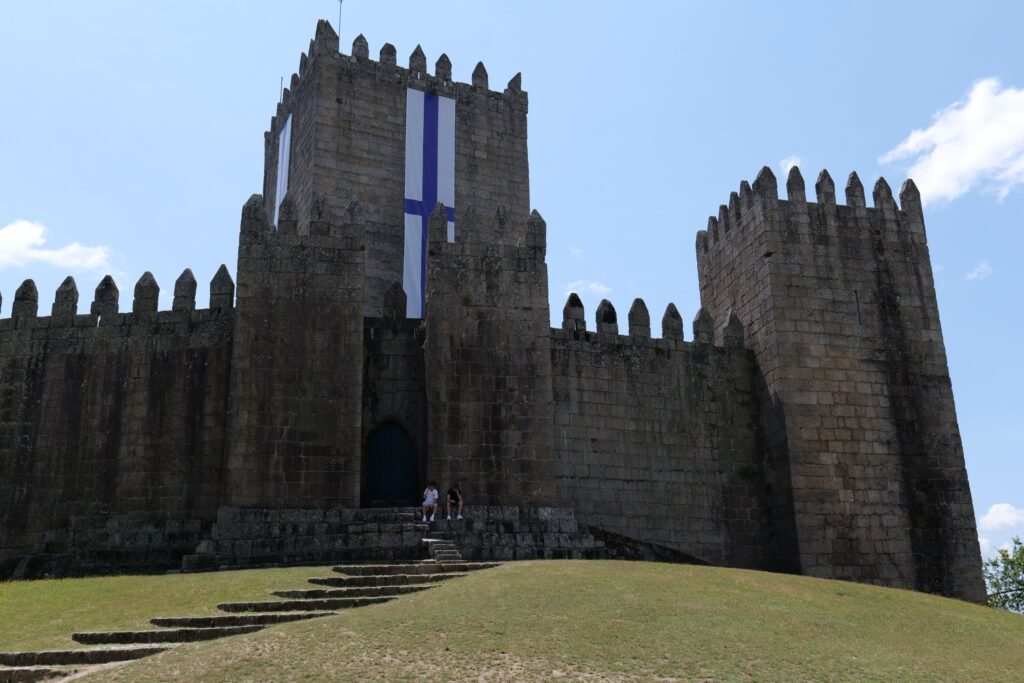
Things to Do in Guimaraes
- Guimaraes Castle – It is believed that Portugal’s first king was born within these walls. You can walk the walls and explore the atmospheric ruins.
- Palace of the Dukes of Braganza – A restored medieval palace that was once the former residence of the first Dukes of Braganza. It’s characterised by its quirky chimneys and stone façade, and you could also visit the museum and armoury inside.
- Largo da Oliveira – The square at the heart of the old town, surrounded by medieval buildings to admire and cafés perfect for outdoor dining.
- Igreja de Nossa Senhora da Oliveira – A late 15th century Gothic church. You can also visit inside to admire the ornate baroque artworks on display.
- Rua de Santa Maria – One of the oldest streets in Guimaraes, but really any of the surrounding streets are well worth exploring!
How to Get to Guimaraes
By Train – Regular direct trains travel from Porto Sao Bento to Guimaraes and take around 1 hour and 15 minutes. The train station is 15 minutes from the historic centre.
By Bus – Rede Expressos and Flixbus run the bus route from Porto Campanha to Guimaraes, which takes around 50 minutes. The bus station is 15 minutes from the historic centre.
By Car – The drive takes around 40 minutes from Porto to Guimaraes.
By Guided Tour – This full day Braga and Guimaraes tour is perfect if you’re short on time and want to tick off two of the best day trips from Porto in one day, plus a visit to Bom Jesus do Monte. You’ll also get entry to Guimaraes Castle and free time to explore on your own!
By Private Tour – This private tour to Braga and Guimaraes is perfect if you want more depth and flexibility. Your private guide will share fascinating, in-depth stories about the area, take you to hidden gems and let you customise your itinerary based on your interests, if you wish.
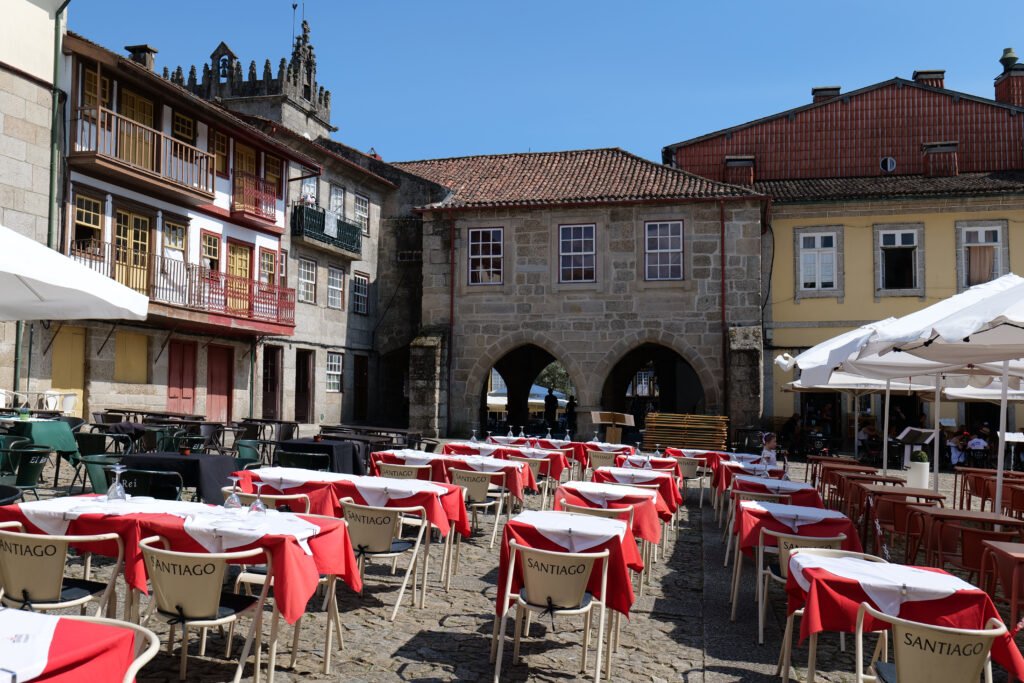
Porto Day Trip Option 3: Aveiro
Aveiro is an easy day trip from Porto if you’re craving sea air, Art Nouveau architecture, and something a little different.
With colourful boats floating down canals and a famously sweet tooth (hello, ovos moles!), this coastal town is ideal for a relaxed solo day.

Things to Do in Aveiro
- Moliceiro Boat Ride – These traditional painted boats used to harvest seaweed and now take tourists through Aveiro’s canals. Yes, it’s touristy, but it’s a must-do in Aveiro!
- Museu de Aveiro – A gorgeous former convent that’s now been turned into a museum, showcasing local history and stunning azulejos.
- Costa Nova – Head to the coast to see the iconic striped beach huts of Costa Nova. You’ll need to take a short taxi ride, local bus or bike ride to get here, but it’s well worth it.
- Try Ovos Moles – A super sweet local pastry made with egg yolk and sugar. (Hello, instant sugar high!)
- Stroll along the canals – The best way to explore Aveiro is on foot, specifically walking along the canals in the city’s Art Nouveau centre.
How to Get to Aveiro
By Train – Regular trains travel from Porto Campanha to Aveiro and take just 35 minutes. The centre is a 20 minute walk from the station.
By Bus – Regular Flixbus and Rede Expressos buses run from Porto Campanha to Aveiro (the bus station is right next to the train station). The journey takes between 50 minutes to 1 hour.
By Car – The drive takes around 45 minutes from Porto to Aveiro.
By Guided Tour – This Aveiro and Costa Nova day tour is ideal if you want to hit the highlights with no planning stress involved! It includes comfy transport, an iconic canal boat ride and plenty of free time to explore both the town and beach.
By Private Tour – This private tour to Aveiro is perfect if you want to skip the boat queues and benefit from the insights of your local guide while you explore. It includes a traditional moliceiro boat ride, a visit to nearby Costa Nova and free time in Aveiro.
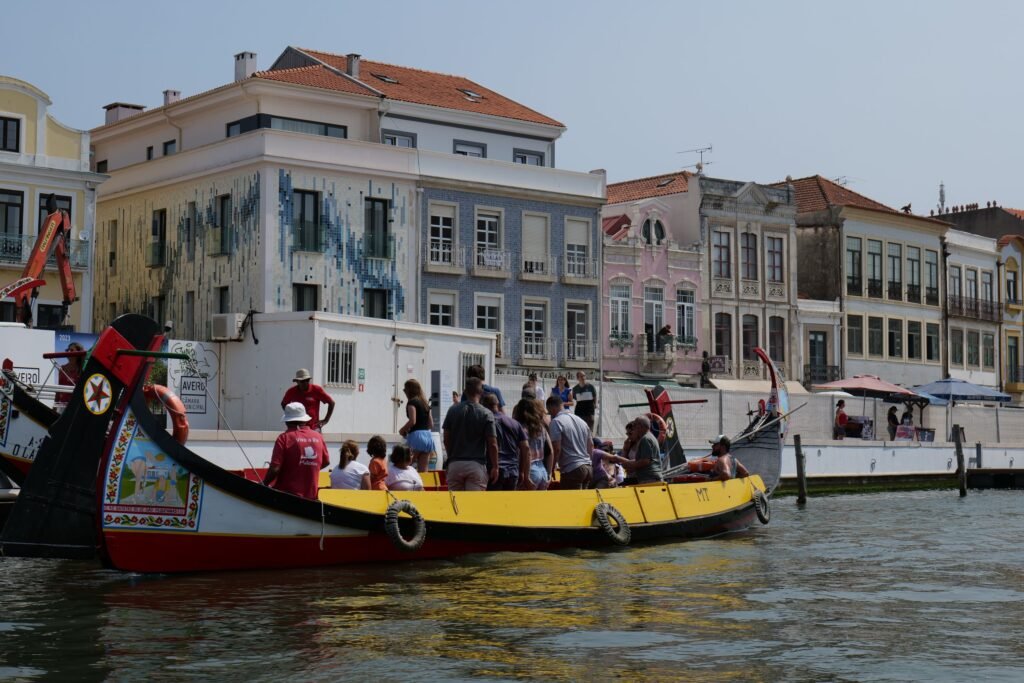
Porto Day Trip Option 4: Douro Valley
The Douro Valley is every bit as scenic as the photos make it look, with rolling hills, stunning river views, and some of the best wine in the world!
It’s not the easiest place to navigate solo unless you hire a car, so joining a small group tour is the perfect option for solo travellers (more on that in just a second!)
Things to Do in the Douro Valley
- Visit a Quinta – These are wine estates where you can tour the vineyards, learn about port production and enjoy a tasting (or two!) Look for one that includes lunch for a dreamy full day trip!
- Miradouro de São Leonardo de Galafura – One of the most iconic viewpoints in the entire northern Portugal. You’ve definitely seen this spot on postcards!
- River Cruise – A boat ride on the Douro (typically from Pinhao), gives you the very best views of the terraced vineyards from the water.
- Pinhao – A charming riverside town, famous for its production of Port wine and, of course, its iconic location on the banks of the Douro River. This is also a great base if you’re planning to stay in the Douro Valley for longer than a day trip!
How to Get to the Douro Valley
By Train – You can take the train to Regua or Pinhao from Porto Sao Bento. Getting to Regua takes around 1 hour 50 minutes. Getting to Pinhao takes around 2 hours 20 minutes.
By Car – The drive takes around 1.5 hours from Porto to Pinhao.
By Guided Tour – This full-day Douro Valley tour from Porto is perfect! It includes visits to two family-run wineries, wine tasting, a traditional lunch and a boat cruise along the Douro River.
By Private Tour – A private tour of the Douro Valley is more expensive but totally worth it if you want a more personalised, luxury experience. This one includes door-to-door service, wine tasting, a traditional picnic lunch and a boat cruise along the Douro River. A private tour is also great if you’re really into wine and want to chat with your guide and the vineyard owners one on one!
Porto Day Trip Option 5: Coimbra
Once Portugal’s capital until Lisbon took over, Coimbra is packed with academic prestige, ancient libraries and a lively student culture.
It’s a bit further from Porto than the other day trips, but still doable and well worth it if you love history and architecture.
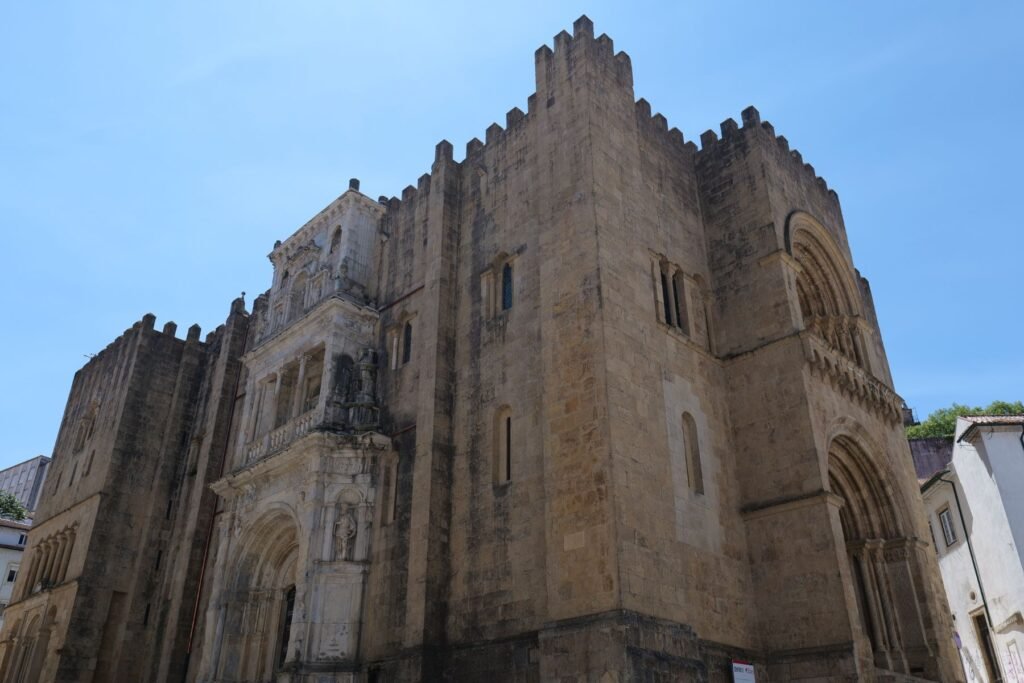
Things to Do in Coimbra
- University of Coimbra – One of the oldest in Europe, with the ornate Joanina Library that’s genuinely breathtaking. (Yes, I know it’s a library, but it’s well worth visiting!)
- Sé Velha (Old Cathedral) – A beautiful example of Romanesque architecture that feels like stepping into a fortress rather than a cathedral. You’ll find it at the top of Coimbra’s old town.
- Botanical Gardens – Run by the university, the botanical gardens in Coimbra are lovely for a peaceful walk, with shady spots to sit, pretty flowers and ancient trees.
- Relax by the Mondego river – Below the city’s old town, you’ll find the Mondego river running through the new city. It’s the perfect spot to sit and relax!
- Listen to live Fado – Coimbra’s version of Fado music is often performed by local students and is a beautiful way to end the day!
How to Get to Coimbra
By Train – Intercity and regional trains travel frequently from Porto Campanha and take 1 hour to 1 hour 45 minutes, depending on whether or not you choose a high speed service. It takes 40 minutes along the river to walk up to the top of the old town.
By Bus – Rede Expressos and ALSA buses take around 1 hour 20 minutes from Porto Campanha to Coimbra. The bus station in Coimbra is just a few minutes from the train station.
By Car – The drive from Porto to Coimbra is around 1 hour 15 minutes.
By Guided Tour – This full-day Coimbra tour includes air-conditioned transport, a walking tour of the university, entry to the top attractions and free time to explore this beautiful city on your own!
By Private Tour – A full-day private tour from Porto, like this one, is perfect if you want to learn more about Coimbra’s fascinating history. Plus, you have the option to customise your itinerary based on your pace and interests, with the help of your own local guide!
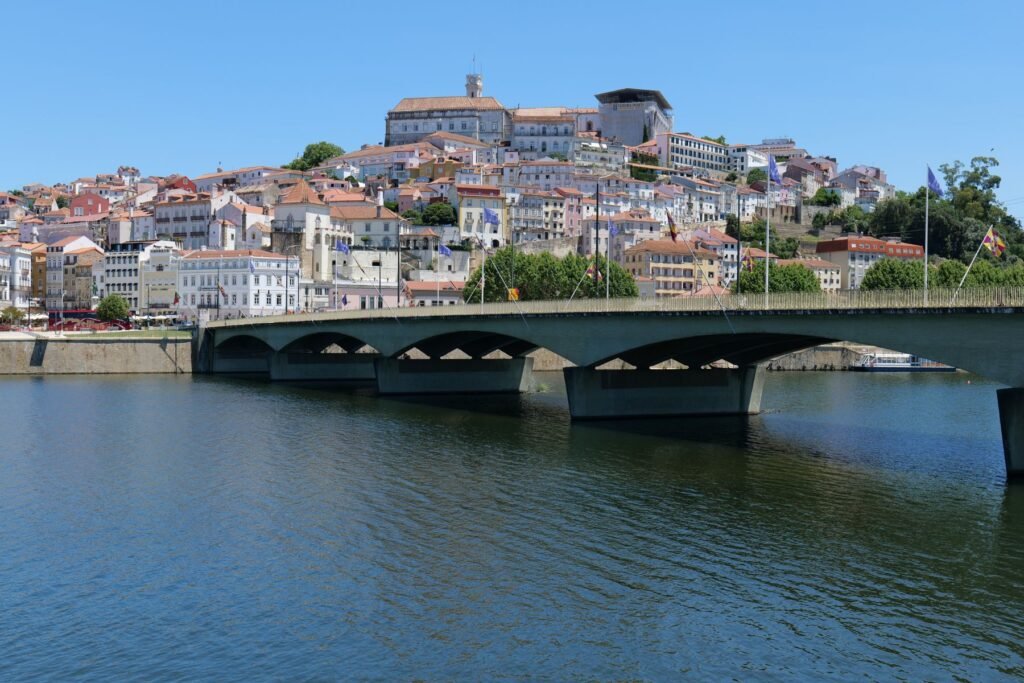
Katie’s Top Tip for Day 3: Choose a day trip that fits your travel style. Braga and Guimaraes are great for history lovers, Aveiro for a slower beach day, Coimbra for a younger vibe, and the Douro Valley if you’re in the mood for wine and spectacular views! For more in-depth details about all of these Porto day trip options and more, you can check out my blog post all about the 7 best day trips from Porto! It covers things to do, logistics and transport options.
Porto FAQs
Where to Stay in Porto
Where you stay will really shape your experience in Porto, especially as a solo traveller.
I recommend basing yourself in or near the city centre, somewhere like Cedofeita, Baixa, or Ribeira, so you’re within walking distance to most of the main sights.
These areas also feel safe, even after dark.
Here are some hotel and hostel suggestions:
Budget – The Passenger Hostel: Housed inside São Bento Station, this is easily one of the most beautiful hostels in Europe. It’s clean, friendly, and has female-only dorms if you prefer a bit more privacy.
Mid-Range – Descobertas Boutique Hotel: A small, stylish spot right near the riverfront in Ribeira. Super comfy beds, great breakfast, and a perfect location for first-time visitors.
Luxury – Torel Avantgarde: If you’re splashing out, this design-forward hotel has river views, an outdoor pool, and the kind of interiors that make you want to redecorate your flat when you get home.
How to Get to Porto
Porto Airport is about 20 minutes from the city centre by metro (in fact, I would say it’s one of the most convenient airports I’ve used in Europe in terms of getting to my accommodation!)
There are direct flights from major European cities and also further afield, such as from the US.
If you’re already in Portugal, the train is your best bet. The Alfa Pendular fast train from Lisbon takes just under 3 hours and drops you right into Porto’s Campanha Station.
Buses are cheaper, but it is a little bit slower, taking around 3 hours 20 minutes.
And if you’re road-tripping through Portugal, the drive up the coast from Lisbon is very scenic, taking around 3 hours too!
Is Porto Walkable? How to Get Around Porto
Porto is very walkable, but be aware that it’s not flat!
In fact, the city is famously hilly and many of the streets are cobbled, which makes exploring on foot a bit of a workout.
But, the historic centre is compact and packed with charm that can only really be discovered by walking – so don’t forget to pack comfy shoes!
For longer journeys (or when your legs need a break from the hills!), the public transport system is also easy and efficient.
The metro runs six lines and connects major neighbourhoods and the airport, and trams and buses fill in the gaps.
There’s also a funicular (the Guindais Funicular) that’s great for bypassing a particularly steep climb between Ribeira and Batalha!
Best Time of Year to Visit Porto
Porto is a year-round city, but the best time to visit really depends on your own unique travel style (and what you’re looking for from your trip, of course!)
Spring (April–early June) and autumn (September-October), are my favourite times of year to visit Porto. The weather is warm but not too hot, flowers are blooming in spring, and the city feels alive without being overcrowded.
Summer in Porto (July–August) are very hot and busy, which means it’s not ideal for a city break. (You’re better off enjoying a beach break in the Algarve during these months!)
Winter in Porto is a lot quieter and cheaper, but expect rain. Lots of it! But, if you enjoy indoor attractions like museums or curling up in cafes (and you don’t mind packing an umbrella!) you’ll still enjoy your trip.
Final Thoughts: How to Spend 3 Days in Porto
So there you have it! A full, doable and genuinely fun 3 days in Porto itinerary that covers the very best of the city’s charm and culture, as well as a glimpse of the beautiful surrounding region of northern Portugal.
So whether you’re wandering those colourful Ribeira streets, sipping port wine with a view or choosing a day trip to discover more of Portugal’s very best places to visit, you’re all set to make the most of every moment of your trip!
What from this 3 days in Porto itinerary has got you most excited for your trip? Let me know in the comments!
Read More About Travel to Portugal:
- Is Porto Safe For Solo Female Travellers? Porto Safety Tips
- How to Spend 3 Days in Porto: Your Perfect Porto Itinerary
- The 7 Best Day Trips From Porto (No Car Needed!)
- 17 Best Things To Do Alone in Lisbon For Solo Travellers
- 11 Best Day Trips from Lisbon You’ll Wish You Knew Sooner
Grab Your Solo Female Travel in Europe Starter Kit:
Pin Me For Later!

